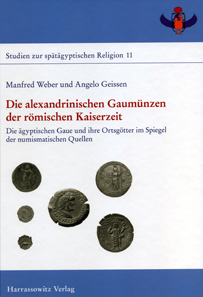by Ursula Kampmann
August 29, 2013 – Egypt is not Cairo as we are learning, once again, from the daily news. And the same goes for antiquity. To reduce Egypt to Alexandria means to neglect a substantial portion of the country. Egypt’s prosperity was created in the countryside, to be more precise in the nomes as we call today the administrative subdivisions already attested in the third millenium BC. They were not only administrative divisions, but every single nome had its own cultic rites reflecting its identity with specific deities. And the nome coinage of the Roman Imperial period refers to these deities.
Manfred Weber, Angelo Geissen, Die alexandrinischen Gaumünzen der römischen Kaiserzeit. Die ägyptischen Gaue und ihre Ortsgötter im Spiegel der numismatischen Quellen. XIV + 406 p. 123 images on 30 pl. 29.7 x 21 cm. Hardcover. Harrassowitz Verlag, Wiesbaden, 2013. ISBN 978-3-447-06846-8. 124 euros (D), 127.50 euros (A), 167 CHF.
It is impressive how much Manfred Weber and Angelo Geissen present to their readers en passant. Of course this book is a complete type catalogue. But the information regarding the interpretation of the coin designs startles even excellent experts of the Roman Empire demonstrating how profoundly the Roman administration in Egypt became acquainted with the local customs.
Nome coins were issued only under very few emperors and only on particular occasions. With sound reasons the authors suggest to link these coin series with the decennial anniversary of enthronement seizing thus on an ancient Egyptian feast. As far back as in the times of the pharaohs the whole country represented by the nomes rendered homage to the pharaoh on occasion of the festival of Sed. Antoninus Pius appears to have referred to this traditional ceremony when celebrating the wedding of Marcus Aurelius and Faustina. Certainly that was the reason why nome coins were issued during his reign.
The authors explain what exactly was shown on the nome coins portraying one nome after the other. First they give a short general introduction into the nome presenting the nome symbol, the most important towns, its location and historical-economical relevance. Then follows a much longer part dealing with the local cults. After this the reader finds a catalogue of all those coin types which name this nome. In the section ‘Ergebnis’ (‘result’) an interpretation of the images on the coins is given.
The photos of the coins are collected on thirty plates. So, if some one would look for a point to criticise they would say that the editors did not consider that most readers of the book will start right from these plates. It is a bit laborious to reach the description beginning from the plates. And unfortunately the coin types have no continuous numbers. Therefore it is rather inconvenient to refer to a specific coin in an auction catalogue by a clearly identifiable quotation.
Many will be vexed by this flaw, however, it would be a shame to not recognise the enormous expansion of our knowledge that the interdisciplinary cooperation has achieved. This book is an eye-opener demonstrating how many-faceted religion really was in antiquity. Simply labelling all deities of the many ancient peoples with the names of the Olympic or Capitoline deities – and thus following the example of the ancient Greeks and Romans – we tend to ignore that the divine powers which these peoples worshipped may have had a completely different meaning to them.
Manfred Weber and Angelo Geissen donate us the consciousness of the religio-historical aspect of the nome issues. And if the fairy of numismatics offered me one wish I would ask for an Egyptological commentary on the common Alexandrinian tetradrachms as well. I am sure that we numismatists are far away from grasping all meanings they contain.
You can order the book directly from here.
If you want to learn more about what nome issues are before reading the book we recommend you this article by Angelo Geissen, which is like the book written in German language.





